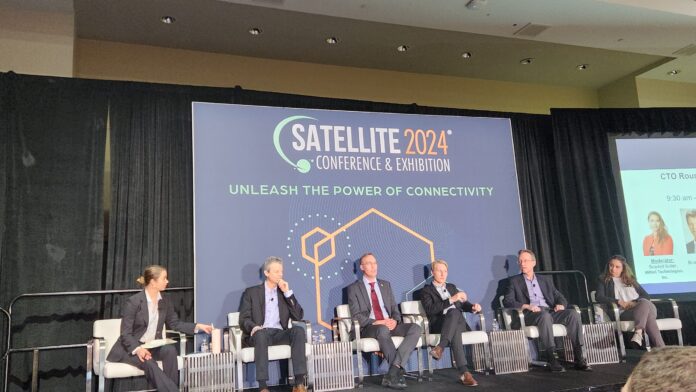WASHINGTON, DC—At the satellite industry’s flagship show, one of the hottest topics is the emerging convergence between terrestrial cellular and satellite systems, what one moderator called the “Great Convergence.”
During a panel of satellite company CTOs on Monday who were discussing “game-changing” tech in the industry, amid discussions of the pros and cons of vertical integration of satellite construction and the impact of lower costs to launch equipment into space, 5G Non-Terrestrial Networks (NTN) was one of the subjects that were top of mind.
Bruno Fromont, CTO of Intelsat, discussed the potential for the scale of the cellular market to change the cost-basis for satellite, because cellular standardization means that chips can be available at relatively high volume and much lower cost than has been the case for proprietary satellite systems–perhaps a tenth of the cost, he estimated. He says Intelsat has been active in 3GPP proceedings on NTN, is exploring NTN on an experimental basis and, based on company conversations at Mobile World Congress Barcelona, sees a path for the manufacture of mobile device chips that support satellite spectrum.
The CTO panelists brought up a number of technical challenges that have to be addressed, however, including spectrum interference between such systems and establishment and maintenance of coverage that could be geostationary-based or based on low-earth-orbit (LEO) space-based cell sites that are constantly moving, highly unlike the stationary terrestrial cell sites. Greg Pelton, CTO of Iridium Communications, also questioned how much of a market there truly is for expanding terrestrial coverage with space-based cellular connectivity–between consumer, enterprise and government use cases, how many new market entrants can actually be sustained? Pelton expects there to be inevitable, long-term consolidation of the multiple new market entrants who are taking advantage of new environment of lower launch costs and the ability to offer LEO satellite-based services at a relatively low cost with a relatively fast time-to-market compared to historical norms in the satellite industry. He also emphasized the importance of having “software-defined” satellites that can more rapidly adapt to new waveforms and features through software updates, rather than requiring new, physical equipment to be launched.
However, because each satellite system is proprietary, industry players compete with each other on their networks’ relative capabilities, in terms of coverage and technology—and several observers over the course of Monday’s panels and presentations expressed concerns that standardization and joining the cellular ecosystem might lead to competition purely, or at least with more emphasis, on a price basis—which was definitely seen as a downside, especially for an industry used to dealing government and defense customers around the world who are much more accustomed to prioritizing making something work over how much it costs.

